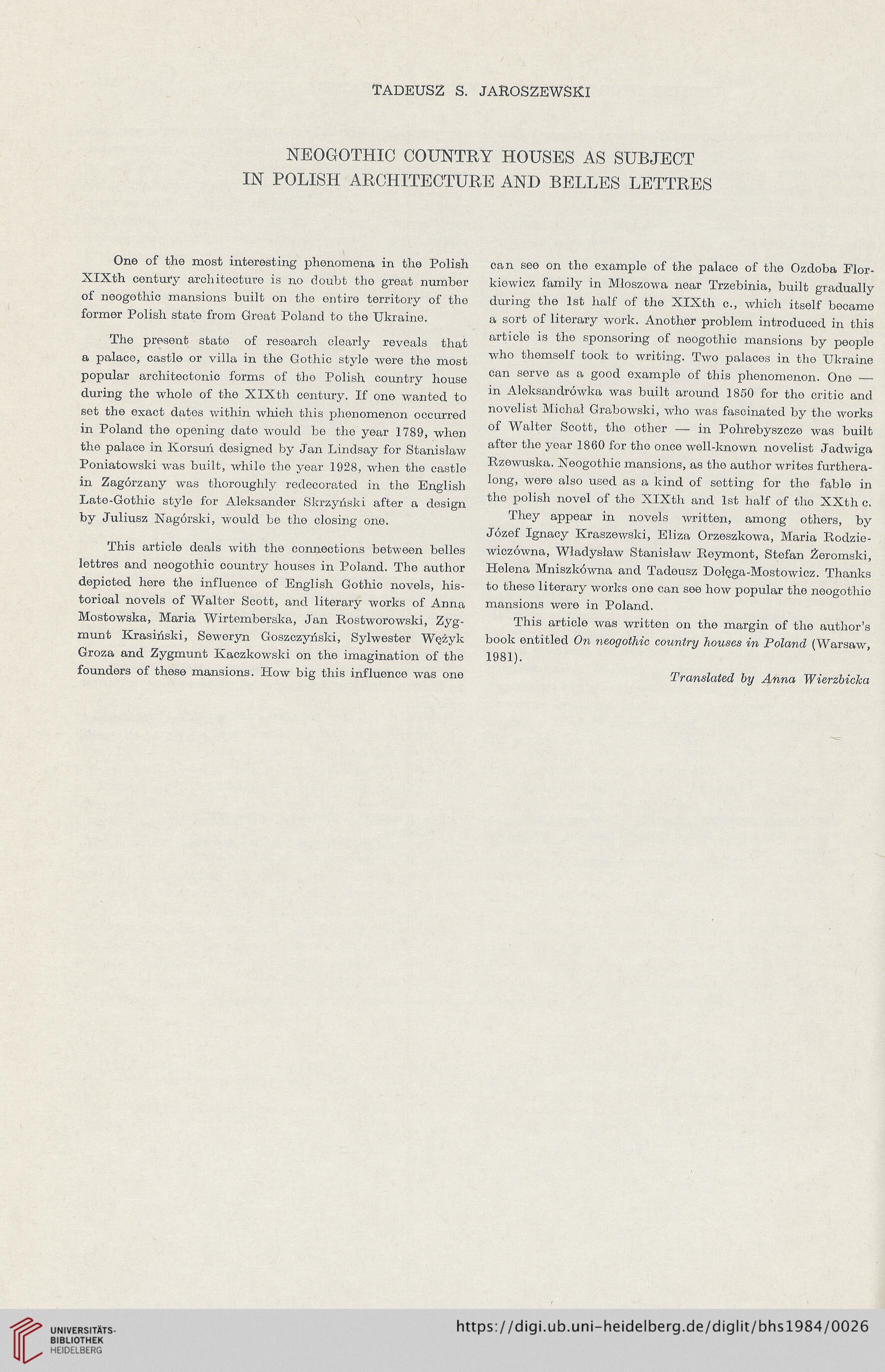TADEUSZ S. JAROSZEWSKI
NEOGOTHIC COUNTRY HOUSES AS SUBJECT
IN POLISH ARCHITECTURE AND BELLES LETTRES
One of the most interesting phenomena in the Polish
XIXth century architecture is no doubt the great number
of neogothic mansions built on the entire territory of the
former Polish state from Great Poland to the Ukrainę.
The present state of research olearly reveals that
a palace, castle or villa in the Gothic style were the most
popular arehitectonic forms of tho Polish country house
during the whole of the XIXth century. If one wanted to
set the exact dates within which this phenomenon occurred
in Poland the opening date would be the year 1789, when
the pałace in Korsuń designed by Jan Lindsay for Stanisław
Poniatowski was built, while the year 1928, when the castle
in Zagórzany was thoroughly redecorated in the English
Late-Gothic style for Aleksander Skrzyński after a design
by Juliusz Nagórski, would be the closing one.
This article deals with the connections between belles
lettres and neogothic country houses in Poland. The author
depicted here the influence of English Gothic novels, his-
torical novels of Walter Scott, and literary works of Anna
Mostowska, Maria Wirtemberska, Jan Rostworowski, Zyg-
munt Krasiński, Seweryn Goszczyński, Sylwester Wężyk
Groza and Zygmunt Kaczkowski on the imagination of the
founders of these mansions. How big this influence was one
can see on the example of the palace of the Ozdoba Flor-
kiewicz family in Młoszowa near Trzebinia, built gradually
during the Ist half of the XIXth c., which itself became
a sort of literary work. Another problem introduced in this
article is the sponsoring of neogothic mansions by people
who themself took to writing. Two palaces in tho Ukraine
can serve as a good example of this phenomenon. One —
in Aleksandrówka was built around 1850 for tho critic and
novolist Michał Grabowski, who was fascinated by tho works
of Walter Scott, the other — in Pohrebyszcze was built
after the year 1860 for tho once well-known novelist Jadwiga
Rzewuska. Neogothic mansions, as the author writes furthera-
long, were also used as a kind of setting for the fable in
the polish novel of the XIXth and Ist half of tho XXth c.
They appear in novels written, among others, by
Józef Ignacy Kraszewski, Eliza Orzeszkowa, Maria Rodzie-
wiczówna, Władysław Stanisław Reymont, Stefan Żeromski,
Helena Mniszkówna and Tadeusz Dołęga-Mostowicz. Thanks
to these literary works one can see how popular the neogothio
mansions were in Poland.
This article was written on the margin of the author's
book entitled On neogothic country houses in Poland (Warsaw,
1981).
Translated by Anna Wierzbicka
NEOGOTHIC COUNTRY HOUSES AS SUBJECT
IN POLISH ARCHITECTURE AND BELLES LETTRES
One of the most interesting phenomena in the Polish
XIXth century architecture is no doubt the great number
of neogothic mansions built on the entire territory of the
former Polish state from Great Poland to the Ukrainę.
The present state of research olearly reveals that
a palace, castle or villa in the Gothic style were the most
popular arehitectonic forms of tho Polish country house
during the whole of the XIXth century. If one wanted to
set the exact dates within which this phenomenon occurred
in Poland the opening date would be the year 1789, when
the pałace in Korsuń designed by Jan Lindsay for Stanisław
Poniatowski was built, while the year 1928, when the castle
in Zagórzany was thoroughly redecorated in the English
Late-Gothic style for Aleksander Skrzyński after a design
by Juliusz Nagórski, would be the closing one.
This article deals with the connections between belles
lettres and neogothic country houses in Poland. The author
depicted here the influence of English Gothic novels, his-
torical novels of Walter Scott, and literary works of Anna
Mostowska, Maria Wirtemberska, Jan Rostworowski, Zyg-
munt Krasiński, Seweryn Goszczyński, Sylwester Wężyk
Groza and Zygmunt Kaczkowski on the imagination of the
founders of these mansions. How big this influence was one
can see on the example of the palace of the Ozdoba Flor-
kiewicz family in Młoszowa near Trzebinia, built gradually
during the Ist half of the XIXth c., which itself became
a sort of literary work. Another problem introduced in this
article is the sponsoring of neogothic mansions by people
who themself took to writing. Two palaces in tho Ukraine
can serve as a good example of this phenomenon. One —
in Aleksandrówka was built around 1850 for tho critic and
novolist Michał Grabowski, who was fascinated by tho works
of Walter Scott, the other — in Pohrebyszcze was built
after the year 1860 for tho once well-known novelist Jadwiga
Rzewuska. Neogothic mansions, as the author writes furthera-
long, were also used as a kind of setting for the fable in
the polish novel of the XIXth and Ist half of tho XXth c.
They appear in novels written, among others, by
Józef Ignacy Kraszewski, Eliza Orzeszkowa, Maria Rodzie-
wiczówna, Władysław Stanisław Reymont, Stefan Żeromski,
Helena Mniszkówna and Tadeusz Dołęga-Mostowicz. Thanks
to these literary works one can see how popular the neogothio
mansions were in Poland.
This article was written on the margin of the author's
book entitled On neogothic country houses in Poland (Warsaw,
1981).
Translated by Anna Wierzbicka




